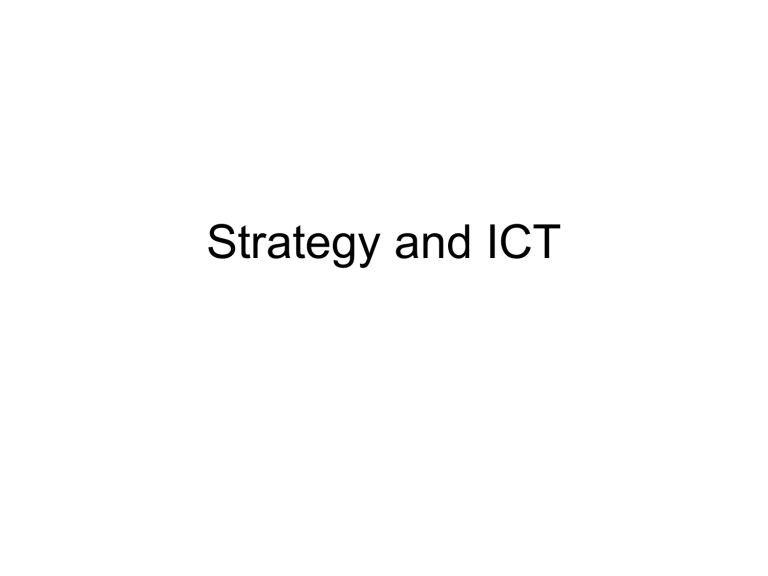
Strategy and ICT
The Information Society
Companies as drivers of change
Competition and strategy
ICT and Strategy
ICT
acceptance
Competitive advantage
Transaction costs, value chain
The New Capitalism
So far
•
•
•
•
Developments in society
Developments in economy
Companies as drivers of change
The existence/size/limits of companies:
- Transaction costs
- Value chain
To do
• Explain the form of companies
• Explain the conduct of companies
Company structure (Morgan and Mintzberg)
Typology (
•
•
•
•
•
•
•
•
Morgan
Machines
Organism
Brains
Culture
Political systems
Psychic prisons
Flux & transformation
Instruments of domination
)
The machine
• Bureaucracy
• Functional specialisation
• Scientific management (Taylor)
The organism
• Adjust to environment
• Organisation as an open system
• Mintzberg
Mintzberg’s typology
•
•
•
•
•
Machine bureaucracy
Division structure
Professional bureaucracy
Simple structure
Adhocracy
Henry Mintzberg
Vijf basisdelen
organisatie
Strategische top
Middenkader
Uitvoerende kern
Vijf fundamentele
coördinatiemethodes
•
•
•
•
•
Onderlinge afstemming
Direct toezicht
Standaardisatie van werkzaamheden
Standaardisatie van resultaten
Standaardisatie van vaardigheden en
kennis, vaardigheden
fundamentele
coördinatiemethodes
Onderlinge afstemming
Direct toezicht
fundamentele coördinatiemethodes
Standaardisatie van
processen/werkzaamheden
Standaardisatie van
vaardigheden kennis
Standaardisatie van
resultaten
Vijf typen organisatiestructuren
•
•
•
•
•
Ondernemersorganisatie
Bureaucratische organisatie
Professionele organisatie
Gediversifieerde organisatie (veel divisies)
Innovatieve organisatie (adhocratie)
Ondernemersorganisatie
(simple structure)
• 1 leider
• Iedereen rechtstreeks verantwoording
afleggen aan de baas
• Baas bepaalt bedrijfsstrategie
• Vrijwel geen middenkader
• Standaardisatie niet aanwezig
• In feite dus een non-structuur
• Vaak bij kleine/net beginnende bedrijven
• Coördinatiemechanisme: Direct toezicht
Ondernemersorganisatie
(simple structure)
Strategische top
Middenkader
Uitvoerende kern
Voorbeeld ondernemersorganisatie
Organogram slagerij Tom
Blijlevens
Slager Tom
Klazien
Winkelbediende
Lidya
Winkelbediende
Klaas
Stagiaire
Pieter
Winkelbediende
De bureaucratische-organisatie
• Bureaucratie: geen verrassingen
• Uitvoerende taak routinematig
• Middenkader rechtstreeks toezicht op
uitvoerders
• Grote technostructuur (voor
standaardisatie)
• Topmanagement voor conflictoplossing
• 1 obsessie: beheersing
• Coördinatiemechanisme: Standaardisatie
van werkzaamheden/processen
De bureaucratischeorganisatie
Strategische top
Middenkader
Uitvoerende kern
Voorbeeld bureaucratischeorganisatie
Divisie-organisatie
•
•
•
•
•
Veel losse eenheden: divisies
Iedere divisie eigen taak/markt
Meerderheid Amerikaanse ondernemingen
Hoofdkantoor stelt prestatienormen vast
Divisies krijgen vaak bureaucratische
structuur om zekerheid te hebben over
resultaten
• Grote ondersteunende staf
• Dus coördinatiemechanisme :
standaardisatie van resultaten
Gediversifieerde organisatie
Voorbeeld gediversifieerde
organisatie
Professionele organisatie
•
•
•
•
Afhankelijk van kennis van uitvoerders
Opleiding bepalend hiervoor
Uitvoerders zeggenschap over eigen werk
Hoge kosten uitvoerders, daarvoor dus
veel ondersteunende staf
• Kleine technostructuur en middenkader
• Coördinatiemechanisme: Standaardisatie
van kennis en vaardigheden
Professionele
organisatie
Strategische top
Middenkader
Uitvoerende kern
Voorbeeld professionele
organisatie
Innovatieve organisatie
(adhocratie)
• Gemaakt om te innoveren: andere structuren
kunnen dit niet
• Flexibele organisaties
• Veel kleine projectgroepen (Projectorganisatie)
• Ook vrij afhankelijk van deskundigheid van
uitvoerders
• Echter: geen standaardisatie van kennis, dit gaat
innovatie tegen
• Coördinatiemechanisme: Onderlinge
afstemming
Innovatieve organisatie
(adhocratie)
Strategische top
Middenkader
Uitvoerende kern
Machine bureaucracy
•
•
•
•
•
•
Simpel werk
Simpele omgeving
Weinig verandering
Gecentraliseerde besluitvorming
Productie/efficiency gericht
Weinig ruimte voor inititatief
Professional bureaucracy
•
•
•
•
Grotere autonomie
Stabiele omgeving
Gecompliceerde taken
Door training standaardisatie en integratie
Simple structure
•
•
•
•
•
Ceo/founder centraal
Informeel
Flexibel
Sterk gecentraliseerd
Snel aanpassen
Adhocracy
• Tijdelijk van aard
• Netwerk organisatie
• Meestal projectorganisatie
Back to Morgan: Brains
• Self learning system
• Cybernetics
• Negative feed back
Culture
• Shared values and norms
• Institutionalisation
Political systems
• Interest groups
• Power/influence
Instruments of domination
• The multinational
Behavior of companies
• Strategic management
Organisation and Management
2007 © Wolters-Noordhoff
• SWOT
• Structure Conduct Performance
• Resource Based View
The strategy perspective
• Structure-Conduct-Performance model
(Porter, 1980, 1985)
Porter’s five forces model
•
Organisation and Management
2007 © Wolters-Noordhoff
Question
• Are there industry characteristics (based
on the five forces model) which explain the
use of the Internet as a channel?
Disappearance of barriers of
entry
•
•
•
•
Economies of scale
Product differentiation
Switching costs
Access to distribution channels
(Shin, 2001; Lucas, 2002)
Existing rivalry
• Winner takes all
• First mover advantage
(Source: Coltman, 2001)
Strategies to realize competitive
advantage (Porter, Treacy and Wiersema)
• Cost leadership/operational excellence
• Differentiation/product leadership
• Focus/customer intimacy
Strategies
Relative
resource
costs
Lower
Parity
Higher
Relative resource-produced value
Lower
Parity
Higher
+
+
-
0
+
-
-
?
?
Question
• Mention examples of companies that use
the Internet to create a competitive
advantage
Growth according to Ansoff
(1965)
PRODUCT
Existing
Existing
Penetration
New
Product development
MARKET
New
Market development
Diversification
Strategy (2)
• Horizontal integration
• Forward vertical integration
• Backward vertical integration
Four dominant alignment perspectives
•
•
•
•
1.
2.
3.
4.
Strategy execution
Technology transformation
Competitive potential
Service level
The resource based view
(strenghts and weaknesses)
Resource based view (Penrose, 1959, Barney, 1991)
• The firm as a bundle of resources
• Competitive advantage when resources
are:
- Valuable
- Rare
- Costly to imitate
- Organized
Results
•
•
•
•
•
•
•
e-Technology as a resource
IT-knowledge as resource
Back-end integration as resource
Direct channel experience (economy of scope)
Advantage of scale and scope disappear
Switching costs by multi channel strategy
Focus on brand(s)
Resources
• Catalog sellers
• Channel conflicts
• Disruption in retailing (Christensen and Tedlow, 2000)
Boston Consultancy Group Portfolio Matrix
•
Organisation and Management
2007 © Wolters-Noordhoff
Organisation and Management
2007 © Wolters-Noordhoff
Organisation and Management
2007 © Wolters-Noordhoff
The role of ICT in companies
Strategic Alignment Model
Business
ICT
Impact
Business Strategy
ICT Strategy
Infrastructure and
processes
Organizational
infrastructure
Alignment
Alignmentmodel Venkatraman & Henderson
Strategic Alignment: levering Information Technology for Transforming Organisations
IBM Systems journal, 32 (1) 1993, p 4-16
Strategic Alignment Model












